The constellation Orion
Características
- Nombre latino
- Orion
- Hemisferio
- Ambos hemisferios
- Visibilidad
- November - March
- Área
- 594 deg²
- Estrella más brillante
- Rigel (HIP number 24436)
- Especialidades
- Open star clusters, emission nebulae, reflection nebulae, diffuse nebulae

The Orion is a striking constellation located along the celestial equator. It is very well-known and is often translated as "the Hunter." In its area are a multitude of interesting deep-sky objects.
Hemisphere, visibility, and area
The constellation Orion stretches across the celestial equator and is visible worldwide. It appears between 80° N and 68° S so it can be observed from almost all inhabited regions of the earth. It is only not visible from the northern areas of Greenland and surrounding islands near the North Pole, as well as from Antarctica.
It can be observed during many seasons, with the months of November through March offering the best conditions. It is especially visible in January.
Orion covers an area of approximately 594 square degrees in the night sky, making it the 26th largest out of all 88 constellations.
The constellation consists of many bright stars, with the brightest one being the star Rigel (Latin: β Orionis, Beta Orionis) with an apparent magnitude of roughly 0.12. Its name comes from Arabic and means "left foot of the middle (one)."
This name fits the visualization of the constellation, as Rigel represents the left foot of the hunter Orion. In some depictions, only the body of the celestial hunter is shown, which already includes a number of very bright stars. In other illustrations, connections are also drawn to stars that represent his arms and a slain animal.
Orion is surrounded by five other constellations in the night sky, including the two astrologically known constellations of Gemini and Taurus. The great river Eridanus, the Lepus, and the Monoceros also border it.
Specialties in the constellation
In the area of Orion, there are several open star clusters, emission nebulae, reflection nebulae, and diffuse nebulae. Some objects can already be seen with the naked eye.
Especially beautiful is the emission nebula with the catalog number M42 or NGC 1976, also known as the Orion Nebula. The nebula is located south of the star belt consisting of Alnitak, Alnilam, and Mintaka. Under good conditions, a non-stellar blur can be perceived. Through a telescope, four trapezium stars and nebulae can be observed.

Another exciting object is the emission nebula NGC 2024, also known as the Flame Nebula. It was discovered by the German-British astronomer William Herschel in January 1786 and can be found east of the star Alnitak.
History and mythology
The strong visibility of the constellation led many peoples to attach their own stories to it.
The Sumerians saw a sheep in this constellation, while the Egyptians recognized a reflection of their god Osiris in it. The Germanic peoples saw a plow in the constellation, the Vikings referred to their god Thor, and for the Chinese, the constellation is one of the 28 zodiac signs.
In Greek mythology, Orion is portrayed as a heroic and talented hunter around whom many different tales revolve.
In one version, he could run faster than any animal and hunted his prey with his bronze club. However, he had no luck in love.
One day, he was tasked by the king of the island of Chios to rid the forests of all wild animals. As thanks, he could marry the king's daughter, Merope. However, Orion only wooed the young princess for one night, causing the king to blind him angrily.
Hoping to be healed, Orion finally set out blind towards the east, towards the light of the morning sun. When he met the goddess of dawn, Eos, she fell in love with him. However, the jealous goddess of the hunt, Artemis, wanted to destroy this love and shot Orion with an arrow.
Ultimately, Orion was immortalized as a constellation in the sky as a reminder of this story.
PublicadoLeer más artículos interesantes

An overview of all 88 constellations
Learn more about all 88 constellations and read interesting information about the mythology, visibility, and features.

Planetario App
¡Descubre el cielo nocturno con nuestra aplicación de planetario!
Disponible para iOS y Android.

Nombrar una estrella en la constelación Hunter
Name a star in a constellation and create something that lasts for eternity.